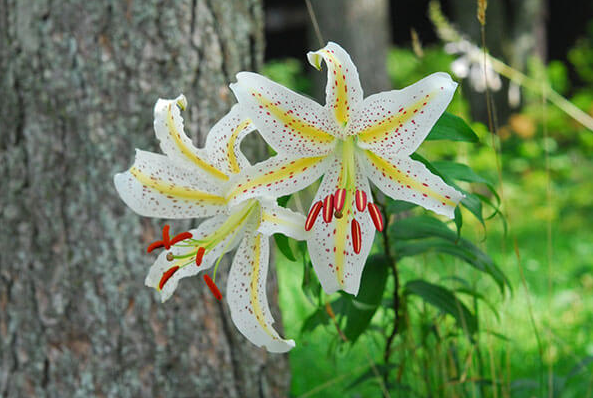
The Golden-rayed Lily, also known as Lilium auratum, is one of the true lilies. It is native to Japan and is sometimes called the goldband lily. It is particularly prevalent in the mountainous regions of Honshu and Shikoku islands, where it’s known as the “yamayuri” (literally meaning “mountain lily”).
The Golden-Rayed Lily was introduced to Europe and North America in the mid to late 19th century. The introduction of Lilium auratum to the Western world is usually credited to Englishman John Gould Veitch of Veitch Nurseries. The lily was officially classified and described by the German botanist Philipp Franz von Siebold in 1902. Von Siebold was a pioneering figure in the study of Japanese flora and fauna. From then, Its genetic traits have been incorporated into many modern lily hybrids.
Golden-rayed lilies are majestic plants, reaching heights of 2-5 feet with sturdy, leafy stems. The leaves are broad and lance-shaped, arranged in whorls around the stem. This lily has some of the largest flowers of any lily species, measuring up to 10 inches in diameter. These blooms are white with a bold central band of golden yellow and are sprinkled with orange or red spots. The petals are trumpet-shaped and outward-curving.
As a perennial, the Golden-rayed lily dies back to the ground in winter but regrows from its bulb each spring. With proper care, these bulbs can live for 5-10 years. This lily is a trooper when it comes to cold temperatures. However, in colder climates (zones 3-4), winter protection like a layer of mulch might be necessary to ensure the bulbs survive the harshest weather. It prefers full sun to partial shade and well-drained soil. It can tolerate some degree of drought once established but performs best with regular watering.
Characteristics of Golden-Rayed Lily (Lilium auratum)
- Size: This lily reach heights of 2-5 feet with sturdy, upright stems. The leaves are broad and lance-shaped, arranged in whorls around the stem.
- Growth Habit: It has an upright growth habit with strong, sturdy stems that can support multiple large blooms.
- Growth Rate: This lily has a moderate growth rate. When planted in the right conditions, it establishes relatively quickly. They take 2-3 seasons to reach their full flowering potential.
- Flower: The flowers are large. They are white with golden-yellow stripes running down the center of each petal and adorned with maroon spots. The petals are slightly recurved.
- Flower Orientation: The blooms face outward and slightly downward.
- Bloom Time: The Golden-Rayed Lily blooms in mid to late summer, from July to August. Each flower lasts for several weeks, and the plant can produce multiple blooms per stem.
- Fragrance: This lily has a strong, sweet fragrance, which can fill the garden with its intoxicating scent.
- Adaptable to Climate: These lilies are adaptable, thriving in USDA zones 3-8. This means they can withstand winter temperatures as low as -40°F (-40°C) with proper care.
- Lifespan: It is a perennial, returning year after year with consistent blooms. With proper care, these bulbs can live for 5-10 years.
- Hardiness: It is relatively hardy and can withstand a range of environmental conditions.
- Disease Resistance: Generally pest-free, but susceptible to lily mosaic virus, botrytis blight and bulb rot.
- Pests: It can be susceptible to pests like aphids, lily beetles and slugs.
Cultivation Tips
Planting
- Location: Choose a sunny location that receives at least 6 hours of direct sunlight daily. can tolerate partial shade but performs best in full sun.
- Soil: Ensure the soil is well-drained and rich in organic matter. This lily prefers slightly acidic to neutral soil (pH 6.0-7.0). Amend heavy clay or sandy soils with compost to improve drainage and fertility.
- Fall or Early Spring: Plant bulbs in the fall or early spring. Fall planting allows the bulbs to establish roots before winter, while early spring planting ensures they are well-settled for the growing season.
- Depth: Plant bulbs about 6 inches deep. This depth protects the bulbs from temperature extremes and provides stability for the tall stems.
- Spacing: Space bulbs 12 to 18 inches apart. Proper spacing ensures good air circulation, reducing the risk of disease and providing room for growth.
Care
- Keep the soil consistently moist but not waterlogged. Water deeply and regularly, especially during dry spells. Mulching around the base of the plants helps retain soil moisture and regulate temperature.
- Use a balanced, slow-release fertilizer (e.g., 10-10-10) in early spring as new growth begins. Follow up with a liquid fertilizer every 4-6 weeks during the growing season. Organic options like compost or well-rotted manure can also be used to enrich the soil.
- Apply a 2-3 inch layer of mulch around the base of the plants. Mulch helps conserve moisture, suppress weeds, and regulate soil temperature.
- Remove spent blooms to encourage more flowers and prevent the plant from wasting energy on seed production.
- Allow the foliage to die back naturally in the fall. The leaves and stems provide energy to the bulb for the next season’s growth.
- These lilies can grow tall and may need staking to prevent them from toppling over, especially in windy areas. Use stakes or plant supports early in the growing season to avoid damaging the bulbs later.
- Check plants regularly for signs of pests such as aphids, lily beetles, and slugs.
- In colder climates (Zones 5-6), apply a thick layer of mulch or straw in late fall to protect the bulbs from freezing temperatures.
- Every 3-4 years, divide overcrowded clumps in the fall after the foliage has died back or in early spring.